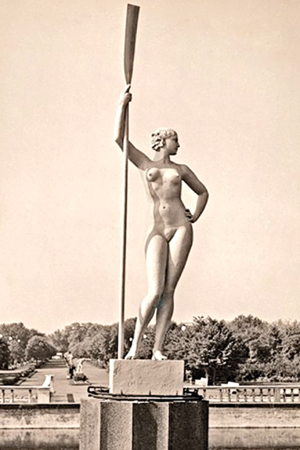The Girl with a Paddle as a symbol of Soviet totalitarianism and erotica
Citius, Altius, Fortius! sports-themed arts exhibition opened at the Kyiv Museum of Russian Art on June 22, 2011
The exhibit presents about 30 paintings, drawings, sculptures, and works of decorative art of the 1930s-1970s from the collection of the Kyiv National Museum of Russian Art.
The items include the works of Aleksandr Deineka, Alexei Pakhomov, Aleksandr Shevchenko, Leonid Soifertis, and Ivan Shadro.
“It was during the Soviet era that the theme of sport first became a major one in the arts, while its central image of a strong and courageous person had become the leitmotif of many artworks in the 1920s and 1930s,” the museum’s research fellow Tetiana Lymar told The Day.
“This theme featured prominently on artistic posters of the time, too. For example, sculptures of sportsmen looked like ancient images of athletes, as can be seen in Deineka’s Boxer and The Boy Jumping into the Water.”
The exhibition’s signature piece is plaster head of Shadro’s eight meter tall The Girl with a Paddle.
The sculpture had been installed in the Gorky Central Park of Culture and Leisure in Moscow in 1935.
It depicted a naked girl standing upright and holding a paddle in her right hand.
Together with the bronze pedestal, it stood about 12 meters tall. Later on, plaster copies of Shadro’s sculpture (and another one by Romuald Iodko, similarly looking, but with the girl wearing a bathing suit and holding a paddle in her left hand) were installed in parks throughout the former USSR.
However, the original Shadro’s work had been subjected to sharp criticism for its erotic connotations. According to a legend, it had been moved to the Park of Culture and Leisure in Luhansk in 1936 and destroyed by shelling at the beginning of Soviet involvement in World War II.
The competitive sports were gaining in importance in the 1950s and 1960s, with the USSR joining the international sports organizations.
It should be noted that Soviet sport was an important ideological weapon in the Cold War.
The exhibit, dedicated to the football Euro-2012, is part of the Realisms of the 20th Century Museum Project. It will last till July 29, 2012.






